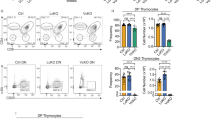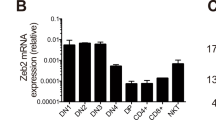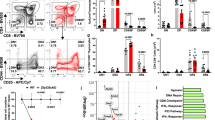Abstract
Cooperation between the stem cell leukemia (SCL) transcription factor and its nuclear partners LMO1 or LMO2 induces aggressive T cell acute lymphoblastic leukemia when inappropriately expressed in T cells. This study examined the cellular and molecular targets of the SCL-LMO complex at the pre-leukemic stage. We show that SCL and its partners are coexpressed in the most primitive thymocytes. Maturation to the pre-T cell stage is associated with a down-regulation of SCL and LMO1 and LMO2, and a concomitant up-regulation of E2A and HEB expression. Moreover, enforced expression of SCL-LMO1 inhibits T cell differentiation and recapitulates a loss of HEB function, causing a deregulation of the transition checkpoint from the CD4−CD8− to CD4+CD8+ stages. Finally, we identify the gene encoding pTα as a downstream target of HEB that is specifically repressed by the SCL-LMO complex.
This is a preview of subscription content, access via your institution
Access options
Subscribe to this journal
Receive 12 print issues and online access
$209.00 per year
only $17.42 per issue
Buy this article
- Purchase on Springer Link
- Instant access to full article PDF
Prices may be subject to local taxes which are calculated during checkout






Similar content being viewed by others
References
Bain, G. & Murre, C. The role of E-proteins. Semin. Immunol. 10, 143–153 (1998).
Robb, L. et al. Absence of yolk sac hematopoiesis from mice with a targeted disruption of the scl gene. Proc. Natl Acad. Sci. USA 92, 7075–7079 (1995).
Porcher, C. et al. The T cell leukemia oncoprotein SCL/tal-1 is essential for development of all hematopoietic lineages. Cell 86, 47–57 (1996).
Gering, M., Rodaway, A.R., Gottgens, B., Patient, R.K. & Green, A.R. The SCL gene specifies haemangioblast development from early mesoderm. EMBO J. 17, 4029–4045 (1998).
Brady, G. et al. Analysis of gene expression in a complex differentiation hierarchy by global amplification of cDNA from single cells. Curr. Biol. 5, 909–922 ( 1995).
Begley, C.G. & Green, A.R. The SCL gene: from case report to critical hematopoietic regulator. Blood 93, 2760–2770 (1999).
Wadman, I.A. et al. The LIM-only protein Lmo2 is a bridging molecule assembling an erythroid, DNA-binding complex which includes the TAL1, E47, GATA-1 and Ldb1/NLI proteins. EMBO J. 16, 3145– 3157 (1997).
Grutz, G.G. et al. The oncogenic T cell LIM-protein Lmo2 forms part of a DNA-binding complex specifically in immature T cells. EMBO J. 17 , 4594–4605 (1998).
Ono, Y., Fukuhara, N. & Yoshie, O. TAL1 and LIM-only proteins synergistically induce retinaldehyde dehydrogenase 2 expression in T-cell acute lymphoblastic leukemia by acting as cofactors for GATA3. Mol. Cell Biol. 18, 6939–6950 (1998).
Krosl, G. et al. Transcription factor SCL is required for c-kit expression and c-Kit function in hemopoietic cells. J. Exp. Med. 188, 439–450 (1998).
Hsu, H.L., Wadman, I. & Baer, R. Formation of in vivo complexes between the TAL1 and E2A polypeptides of leukemic T cells. Proc. Natl Acad. Sci. USA 91, 3181–3185 (1994).
Chervinsky, D.S. et al. Disordered T-cell development and T-cell malignancies in SCL LMO1 double-transgenic mice: parallels with E2A-deficient mice. Mol. Cell Biol. 19, 5025–5035 (1999).
Larson, R.C. et al. Protein dimerization between Lmo2 (Rbtn2) and Tal1 alters thymocyte development and potentiates T cell tumorigenesis in transgenic mice . EMBO J. 15, 1021–1027 (1996).
Condorelli, G.L. et al. T-cell-directed TAL-1 expression induces T-cell malignancies in transgenic mice. Cancer Res. 56, 5113 –5119 (1996).
Kelliher, M.A., Seldin, D.C. & Leder, P. Tal-1 induces T cell acute lymphoblastic leukemia accelerated by casein kinase IIalpha. EMBO J. 15, 5160 –5166 (1996).
Aplan, P.D. et al. An scl gene product lacking the transactivation domain induces bony abnormalities and cooperates with LMO1 to generate T-cell malignancies in transgenic mice. EMBO J. 16, 2408– 2419 (1997).
Bain, G. et al. E2A deficiency leads to abnormalities in alphabeta T-cell development and to rapid development of T-cell lymphomas. Mol. Cell Biol. 17, 4782–4791 (1997).
Barndt, R., Dai, M.F. & Zhuang, Y. A novel role for HEB downstream or parallel to the pre-TCR signaling pathway during αβ thymopoiesis. J. Immunol. 163, 3331–3343 ( 1999).
Kim, D., Peng, X.C. & Sun, X.H. Massive apoptosis of thymocytes in T-cell-deficient Id1 transgenic mice. Mol. Cell Biol. 19, 8240 –8253 (1999).
Blom, B. et al. Disruption of αβ but not of γδ T cell development by overexpression of the helix-loop-helix protein Id3 in committed T cell progenitors. EMBO J. 18, 2793– 2802 (1999).
von Boehmer, H. et al. Pleiotropic changes controlled by the pre-T-cell receptor. Curr. Opin. Immunol. 11, 135– 142 (1999).
Aplan, P.D. et al. Disruption of the human SCL locus by “illegitimate” V-(D)-J recombinase activity. Science 250, 1426–1429 (1990).
Godfrey, D.I. & Zlotnik, A. Control points in early T-cell development . Immunol. Today 14, 547– 553 (1993).
Mouthon, M.A. et al. Expression of tal-1 and GATA-binding proteins during human hematopoiesis. Blood 81, 647– 655 (1993).
Kallianpur, A.R., Jordan, J.E. & Brandt, S.J. The SCL/TAL-1 gene is expressed in progenitors of both the hematopoietic and vascular systems during embryogenesis. Blood 83, 1200–1208 ( 1994).
Elefanty, A.G. et al. Characterization of hematopoietic progenitor cells that express the transcription factor SCL, using a lacZ “knock-in” strategy . Proc. Natl Acad. Sci. USA 95, 11897– 11902 (1998).
Kenny, D.A., Jurata, L.W., Saga, Y. & Gill, G.N. Identification and characterization of LMO4, an LMO gene with a novel pattern of expression during embryogenesis. Proc. Natl Acad. Sci. USA 95, 11257–11262 (1998).
Anderson, G., Hare, K.J. & Jenkinson, E.J. Positive selection of thymocytes: the long and winding road. Immunol. Today 20, 463– 468 (1999).
Wilson, R.B. et al. Repression of immunoglobulin enhancers by the helix-loop-helix protein Id: implications for B-lymphoid-cell development. Mol. Cell Biol. 11, 6185–6191 (1991).
Reizis, B. & Leder, P. Expression of the mouse pre-T cell receptor α gene is controlled by an upstream region containing a transcriptional enhancer. J. Exp. Med. 189, 1669– 1678 (1999).
Sawada, S. & Littman, D.R. A heterodimer of HEB and an E12-related protein interacts with the CD4 enhancer and regulates its activity in T-cell lines. Mol. Cell Biol. 13, 5620– 5628 (1993).
Winandy, S., Wu, L., Wang, J.H. & Georgopoulos, K. Pre-T cell receptor (TCR) and TCR-controlled checkpoints in T cell differentiation are set by Ikaros. J. Exp. Med. 190, 1039– 1048 (1999).
Henning, S.W. & Cantrell, D.A. p56lck signals for regulating thymocyte development can be distinguished by their dependency on Rho function . J. Exp. Med. 188, 931– 939 (1998).
Bain, G., Romanow, W.J., Albers, K., Havran, W.L. & Murre, C. Positive and negative regulation of V(D)J recombination by the E2A proteins. J. Exp. Med. 189, 289–300 (1999).
Morrow, M.A., Mayer, E.W., Perez, C.A., Adlam, M. & Siu, G. Overexpression of the Helix-Loop-Helix protein Id2 blocks T cell development at multiple stages. Mol. Immunol. 36, 491 –503 (1999).
Smith, K.S., Rhee, J.W., Naumovski, L. & Cleary, M.L. Disrupted differentiation and oncogenic transformation of lymphoid progenitors in E2A-HLF transgenic mice. Mol. Cell Biol. 19, 4443–4451 (1999).
Look, A.T. Oncogenic transcription factors in the human acute leukemias. Science 278, 1059–1064 ( 1997).
Wang, J. et al. The t(14;21)(q11.2;q22) chromosomal translocation associated with T-cell acute lymphoblastic leukemia activates the BHLHB1 gene. Proc. Natl Acad. Sci. USA 97, 3497– 3502 (2000).
Peverali, F.A. et al. Regulation of G1 progression by E2A and Id helix-loop-helix proteins. EMBO J. 13, 4291– 4301 (1994).
Prabhu, S., Ignatova, A., Park, S.T. & Sun, X.H. Regulation of the expression of cyclin-dependent kinase inhibitor p21 by E2A and Id proteins . Mol. Cell Biol. 17, 5888– 5896 (1997).
McGuire, E.A., Rintoul, C.E., Sclar, G.M. & Korsmeyer, S.J. Thymic overexpression of Ttg-1 in transgenic mice results in T-cell acute lymphoblastic leukemia/lymphoma. Mol. Cell Biol. 12 , 4186–4196 (1992).
Zhuang, Y., Cheng, P. & Weintraub, H. B-lymphocyte development is regulated by the combined dosage of three basic helix-loop-helix genes, E2A, E2-2, and HEB. Mol. Cell Biol. 16, 2898–2905 (1996).
Hugo, P., Boyd, R.L., Waanders, G.A., Petrie, H.T. & Scollay, R. Timing of deletion of autoreactive Vβ6+ cells and down-modulation of either CD4 or CD8 on phenotypically distinct CD4+8+ subsets of thymocytes expressing intermediate or high levels of T cell receptor. Int. Immunol. 3, 265–272 (1991).
Chomczynski, P. & Sacchi, N. Single-step method of RNA isolation by acid guanidinium thiocyanate phenol-chloroform extraction . Anal. Biochem. 162, 156– 159 (1987).
Nordeen, S.K. Luciferase reporter gene vectors for analysis of promoters and enhancers. Biotechniques 6, 454–458 (1988).
Hernandez-Munain, C., Sleckman, B.P. & Krangel, M.S. A developmental switch from TCRδ enhancer to TCRα enhancer function during thymocyte maturation. Immunity 10, 723–733 ( 1999).
Aplan, P.D. et al. The SCL gene is formed from a transcriptionally complex locus . Mol. Cell Biol. 10, 6426– 6435 (1990).
Dong, W.F. et al. Molecular characterization of a chromosome translocation breakpoint t(11;14)(p13;q11) from the cell line KOPT-K1. Leukemia 9, 1812–1817 (1995).
Nelson, C., Shen, L.P., Meister, A., Fodor, E. & Rutter, W.J. Pan: a transcriptional regulator that binds chymotrypsin, insulin, and AP-4 enhancer motifs. Genes Dev. 4, 1035–1043 (1990).
Hawley, R.G., Lieu, F.H., Fong, A.Z. & Hawley, T.S. Versatile retroviral vectors for potential use in gene therapy. Gene Ther. 1, 136–138 (1994).
Acknowledgements
We thank N. Tessier for assistance with cell sorting and M. Ratcliffe and A. Veillette for reading the manuscript. This work was supported in part by a grant from the Medical Research Council of Canada and a postdoctoral fellowship from the French Medical Research Foundation and the Fonds de la recherche en santé du Québec (S.H.).
Author information
Authors and Affiliations
Corresponding author
Supplementary information
Rights and permissions
About this article
Cite this article
Herblot, S., Steff, AM., Hugo, P. et al. SCL and LMO1 alter thymocyte differentiation: inhibition of E2A-HEB function and pre-Tα chain expression. Nat Immunol 1, 138–144 (2000). https://doi.org/10.1038/77819
Received:
Accepted:
Issue Date:
DOI: https://doi.org/10.1038/77819
This article is cited by
-
LMO2 expression is frequent in T-lymphoblastic leukemia and correlates with survival, regardless of T-cell stage
Modern Pathology (2022)
-
Loss of Zfp335 triggers cGAS/STING-dependent apoptosis of post-β selection thymocytes
Nature Communications (2022)
-
The transcription factor TAL1 and miR-17-92 create a regulatory loop in hematopoiesis
Scientific Reports (2020)
-
Surfaceome interrogation using an RNA-seq approach highlights leukemia initiating cell biomarkers in an LMO2 T cell transgenic model
Scientific Reports (2019)
-
Oncogenic transcriptional program driven by TAL1 in T-cell acute lymphoblastic leukemia
International Journal of Hematology (2019)



